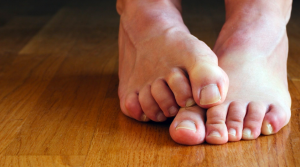Anatomy
Each of the four small toes has two joints between the ball of the foot and the tip of the toe. The first is called your distal interphalangeal joint which is closest to the end of the toe, and the second is your proximal interphalangeal joint, which is closer to the ball of the foot. The names of these joints come from their position between the three toe bones, called the phalanges. Hence, interphalangeal. Hammer toes describe the bending (flexion) of the proximal interphalangeal joint.What causes hammer toes?
 Hammer toes are most likely to affect the second or third toes, though can affect any of the toes. Common causes or contributing factors can include:
Hammer toes are most likely to affect the second or third toes, though can affect any of the toes. Common causes or contributing factors can include:
- Tight or ill-fitting footwear
- Previous injuries
- Genetic predisposition
- An imbalance between muscles and tendons
- Arthritis
- Pressure from a bunion affecting the first toe
- Having a long second toe
 What are the symptoms?
What are the symptoms?







